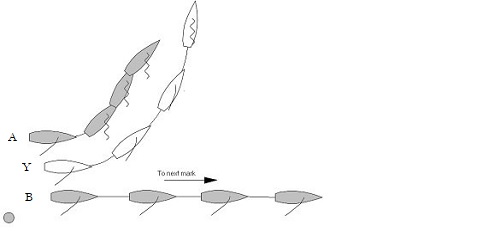


Section L – Other Rules
TR CALL L5
Rule 21.2, Taking a Penalty
Rule 44.2, One-Turn and Two-Turns Penalties
D2.3, Penalties Initiated by an Umpire
Question 1
How will the umpires decide that a boat has taken a penalty correctly under rule 44.2?
Answer 1
A boat takes a penalty correctly when, as soon as possible after an incident or after
being penalized by the umpires, she first sails well clear and then makes the required
number of turns. The answers below clarify these requirements.
Question 2
A and B are opponents of Y. Rule 17 does not apply to Y who has been penalized.A
has to alter course and slow down to avoid Y and protests. What should the call be?

Answer 2
Although Y breaks no rule of Part 2, she fails to sail clear as soon as possible. In
position 1 she is able to slow down, fall astern of both B and A and then sail clear.
Penalize Y under rule D2.3(f).
Question 3
When is a boat subject to rule 21.2?
Answer 3
Rule 21.2 begins to apply when a boat is clearly turning in order to take a penalty. It
ceases to apply when the boat completes the last required tack or gybe or when she
stops taking her penalty before it is complete.
Question 4
When may the umpires take action against a boat that has failed to take a penalty
correctly?
Answer 4
The umpires should penalize a boat that fails to take a penalty correctly as follows
(a) under rule D2.3(e) when the boat has clearly indicated that she will take
a penalty and breaks rule D1.3(b);
(b) under rule D2.3(f) when the penalty was signalled by an umpire and the
boat breaks rule D2.5.
In both cases, the failure may be a failure to get well clear as soon as possible, or a
failure to take the penalty correctly in accordance with rule 44.2.
A right-of-way boat that is sailing to get clear retains right of way until rule 21.2 starts
to apply to her. A boat that interferes with another boat while sailing clear, when she
has a clear alternative, does not sail clear as soon as possible.






